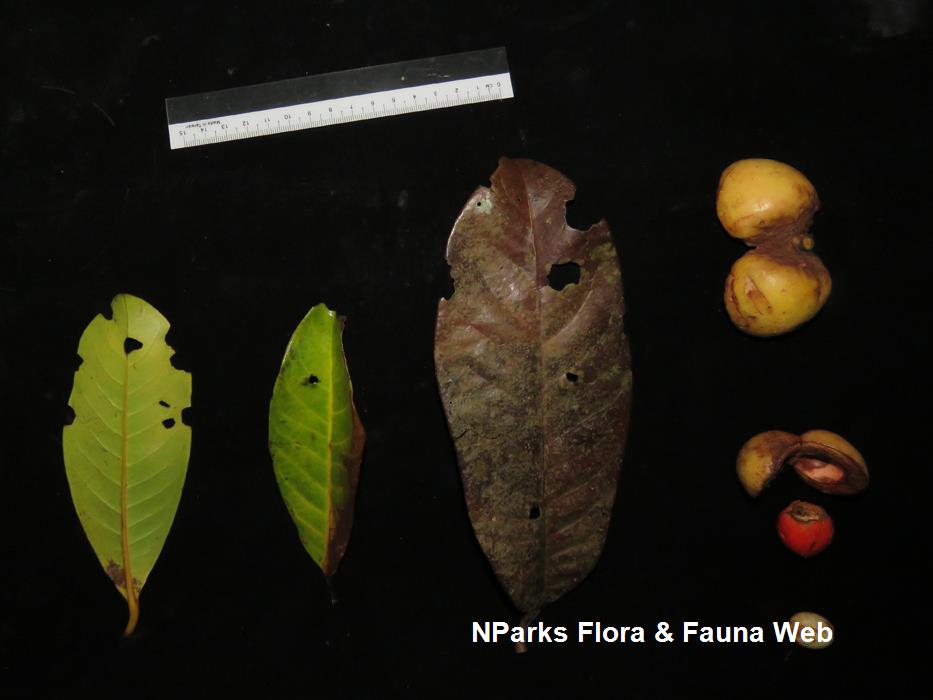
Back
Horsfieldia wallichii (Hook.f. & Thomson) Warb.
| Family Name: | Myristicaceae |
| Synonyms: | Myristica wallichii Hook.f. & Thomson |
Name
Classifications and Characteristics
| Plant Division | Angiosperms (Flowering Seed Plants) (Dicotyledon) |
|---|---|
| Plant Growth Form | Tree (Big (>30m)) |
| Lifespan (in Singapore) | Perennial |
| Mode of Nutrition | Autotrophic |
| Plant Shape | Columnar, Irregular |
| Maximum Height | 35 m |
Biogeography
| Native Distribution | Sumatra, Peninsular Malaysia, Singapore, and Borneo |
|---|---|
| Native Habitat | Terrestrial (Primary Rainforest, Mountain, Secondary Rainforest) |
| Preferred Climate Zone | Tropical |
| Local Conservation Status | Native to Singapore (Critically Endangered (CR)) |
Description and Ethnobotany
| Growth Form | It is a tree up to 35 m tall, and with hollow twigs. |
|---|---|
| Foliage | Its alternate, stalked leaves possess membranous to leathery leaf blades that are egg-shaped-oblong to oblong-lance-shaped, greenish above, and 14–40 by 4–12 cm. The blades are covered with fine, 0.3–0.8 mm long hairs, and are dark brown with blackish dots and dashes below when dried. |
| Flowers | The species is dioecious with individual trees producing either male or female flowers. Its flowering shoots (inflorescences) develop behind the leaves on twigs, and possess 0.5–1 mm long hairs. Its male inflorescence is 10–33 by 6–22 cm, and the male flowers are in clusters of 5–12. Its female inflorescence is 3–7 cm long. Male and female flowers are yellow, and the female flowers are larger than the male flowers. |
| Fruit | Each fruiting cluster (infructescence) contains 2–9 fruits. Its fruits are egg-shaped, smooth or wrinkled, yellow, orange or red when ripe, and 4–7 by 3–4.5 cm. Its seeds are ovoid, and possess an orange, fleshy covering (aril). |
| Habitat | It grows in lowland, heath and ridge-top forests, up to 500 m altitude. It occurs locally in the Central Catchment Nature Reserve. |
| Associated Fauna | Its flowers are insect-pollinated. Its aril-covered seeds are eaten by hornbills and other forest frugivores. |
| Cultivation | It can be propagated by seed. |
| Etymology | Horsfieldia, named after Dr. Thomas Horsfield (1773–1859), an American botanist who explored in the Malesian islands; wallichii, named after Nathaniel Wallich (1786–1854), originally Nathan Wolff, Danish botanist, and superintendent of the Calcutta Botanic Garden from 1814–1841, during which he contributed immensely to the knowledge of the Indian flora |
Landscaping Features
| Landscaping | It is suitable for planting along streetscapes and parks. |
|---|---|
| Desirable Plant Features | Ornamental Foliage |
| Landscape Uses | General, Suitable for Roadsides, Parks & Gardens, Small Gardens |
Fauna, Pollination and Dispersal
| Fauna Pollination Dispersal Associated Fauna | Bird-Attracting |
|---|---|
| Pollination Method(s) | Biotic (Fauna) |
| Seed or Spore Dispersal | Biotic (Fauna) |
Plant Care and Propagation
| Light Preference | Full Sun, Semi-Shade |
|---|---|
| Water Preference | Moderate Water |
| Plant Growth Rate | Moderate |
| Rootzone Tolerance | Moist Soils, Fertile Loamy Soils |
| Propagation Method | Seed |
Foliar
| Foliage Retention | Evergreen |
|---|---|
| Mature Foliage Colour(s) | Green |
| Mature Foliage Texture(s) | Hairy / Hirsute, Leathery |
| Foliar Type | Simple / Unifoliate |
| Foliar Arrangement Along Stem | Alternate |
| Foliar Attachment to Stem | Petiolate |
| Foliar Shape(s) | Non-Palm Foliage (Obovate, Lanceolate, Oblong) |
| Foliar Venation | Pinnate / Net |
| Foliar Margin | Entire |
Floral (Angiosperm)
| Flower & Plant Sexuality | Unisexual Flowers , Dioecious |
| Flower Colour(s) | Yellow / Golden |
|---|
| Flower Grouping | Cluster / Inflorescence |
| Flower Location | Axillary |
Fruit, Seed and Spore
| Mature Fruit Colour(s) | Orange |
|---|---|
| Fruit Classification | Simple Fruit |
| Fruit Type | Dehiscent Dry Fruit , Capsule |
Image Repository
Others
| Master ID | 31807 |
|---|---|
| Species ID | 6207 |
| Flora Disclaimer | The information in this website has been compiled from reliable sources, such as reference works on medicinal plants. It is not a substitute for medical advice or treatment and NParks does not purport to provide any medical advice. Readers should always consult his/her physician before using or consuming a plant for medicinal purposes. |






